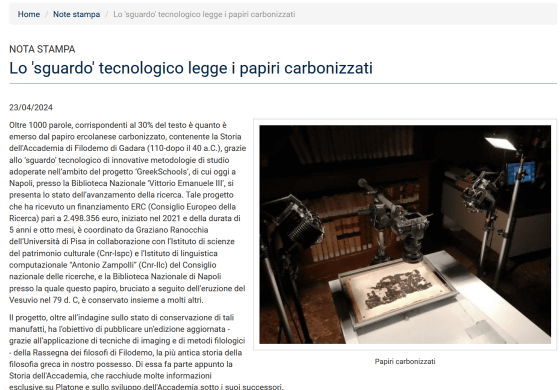'Philosopher Plato's Burial Site Revealed from Charred Scrolls in Ancient Volcanic Eruption'

The exact location of
The 'sguard' technological foundations and funding | National Research Council
https://www.cnr.it/it/nota-stampa/n-12655/lo-sguardo-tecnologico-legge-i-papiri-carbonizzati

Plato's burial place finally revealed after AI deciphers ancient carbonized scroll in Mount Vesuvius eruption | Live Science
https://www.livescience.com/archaeology/romans/platos-burial-place-finally-revealed-after-ai-deciphers-ancient-scroll-carbonized-in-mount-vesuvius-eruption
Deciphered Herculaneum papyrus reveals precise burial place of Plato | Ars Technica
https://arstechnica.com/science/2024/04/deciphered-herculaneum-papyrus-reveals-precise-burial-place-of-plato/
Mount Vesuvius , located near Naples in Italy, erupted violently in 79 AD, destroying ancient Roman cities such as Pompeii and Herculaneum . In the ruins of the city of Herculaneum, buried under pyroclastic flows, a large number of valuable books (Herculaneum papyri) have been excavated from a building called the ' Villa of Papyrus .'
Many of the scrolls excavated from the Papyrus Villa were carbonized and brittle, and many of them are unreadable because they crumble when opened, but modern attempts are underway to decipher the scrolls using the latest technology. In one such attempt, a project called the Vesuvius Challenge , AI researchers from around the world attempted to decipher the scrolls and succeeded in deciphering a total of more than 2,000 characters of text, far exceeding initial expectations.
Winning team of 'Vesuvius Challenge', a contest to decipher ancient Roman scrolls charred by volcanic eruption using AI, is announced - GIGAZINE

Then, on April 23, 2024, the Institute of Heritage Science of the Italian Academic Council reported that the deciphering of the Herculaneum Papyrus had revealed Plato's burial site. The Institute of Heritage Science is using a scanning technology called 'bionic eye' that combines infrared and thermal imaging, molecular imaging, X-ray tomography, and digital optical microscopes to decipher the Herculaneum Papyrus.
The research team deciphered scrolls left by the Epicurean philosopher Philodemus . The Villa of the Papyri was a villa owned by Julius Caesar 's father-in-law, where Philodemus is known to have lived for a time. Many of Philodemus' writings have also been discovered in the Villa of the Papyri.
According to a statement from the research team, the deciphered scrolls describe the Academy , a school that Plato established on the outskirts of Athens , and they have succeeded in deciphering more than 1,000 words, or about 30% of the text. One particularly eye-catching discovery is the fact about where Plato was buried. Until now, it was known that Plato was buried on the grounds of the Academy, but the exact location was unknown. The newly deciphered texts reveal that Plato was buried in a 'private area reserved for the Platonic school,' which was near the Mouseion (school).

In addition, while it was previously believed that Plato was sold into slavery around 387 BC, the newly deciphered texts suggest that he may have been sold into slavery in 404 BC or in 399 BC, shortly after the death of Socrates .
'This is an almost radically altered text compared to previous editions, suggesting a series of new and concrete facts about various academic philosophers. By understanding the writings in the new edition, researchers have arrived at unexpected interdisciplinary inferences about ancient philosophy, Greek biography and literature, and the history of the book,' said historian Graziano Ranocchia.
Related Posts:
in Science, Posted by log1h_ik






